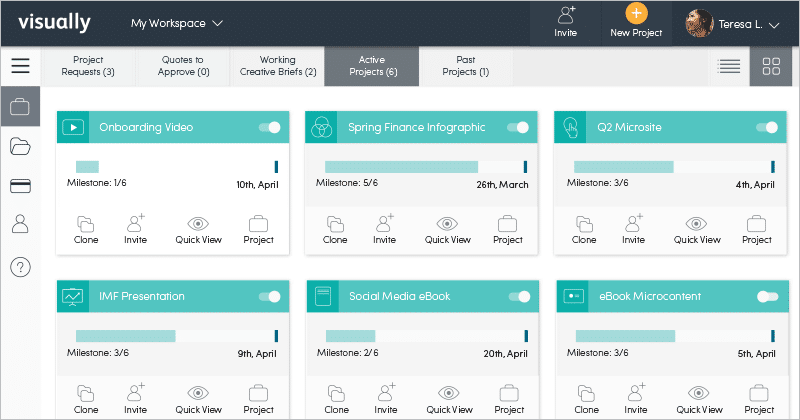No matter what your area of operation is, if you want to stand out on the web, you’ll eventually need to scale up your content production, either to meet growing demand or due to competition pressure.
This is when companies mature their Content Marketing strategy, recognizing that producing materials at scale requires well-structured supervision to ensure the desired results.
However, it all begins with proper planning. In this article, we’ll break down this issue to help your company expand its online presence. Throughout the reading, we’ll address:
Download this post by entering your email below
What Is Scalable Content Production?
Scaling your content production goes beyond increasing the number of posts. It’s about better serving your buyer persona by providing as much material as possible to educate, assist, and guide them along their buying journey.
Thus, it makes no sense to simply fire off a massive number of posts purely to increase your blog’s volume of content.
Having a high standard of quality is essential since search engines are committed to delivering relevant results to users.
Besides that, modern consumers are aware of what they consume and are becoming increasingly demanding.
Moreover, we cannot forget that blog posts, infographics, videos, ebooks, and interactive materials are all part of any major marketing strategy.
This means that each of your posts must fit into the strategy you have planned. This is what will make your blog grow at a consistent rate.
Why Scale Your Blog’s Content Production?
If the top priority of content production is quality, why should we worry about quantity? After all, what is the ideal posting frequency for a blog to be successful on the Internet?
These are very common and somewhat controversial questions. You don’t need to dig through many sites to find interesting discussions on this subject.
We can say that quantity really matters, especially when the subject is to build authority on the web.
Still, there is no way to define an ideal average number of publications because there is none.
Except in very specific searches (long-tail), the content that ranks on the first page of search results usually belongs to domains with a considerable volume of publications.
That being said, it is clear that scaling content production is fundamental to having good results with organic traffic. However, it is the quality of your content and the effectiveness of your strategy that will take your brand to the top.
What you must absolutely avoid is overdoing it, which, in this case, means saturating your production, causing a loss of focus, and affecting your publications’ standards.
Types of Content Producers
Content production doesn’t happen in isolation or with just one person.
Instead, you need a team of content producers to achieve your goals and create content promptly.
Your team will consist of various individuals, including:
- Content Managers
- Content Strategists
- Writers and ghostwriters
- Researchers
- Subject-Matter Experts
- Project Managers
- Editors
- Proofreaders
- Photographers
- Videographers
- UX Designers
- Graphic Designers
- Developers
While smaller teams might have individuals fulfilling multiple roles for content production, having designated roles is crucial for achieving success.
Not every team will require the same roles to be filled either.
For instance, if your team doesn’t create video content, there’s no need for a videographer. You can also consider outsourcing some of these roles instead of having a full-time editor or photographer in your company.
Building your team might take time, especially if you have just started thinking about content production in your business.
However, over time, you can expand your content production to new channels and add to your team. This will allow your business to grow content organically, aligning with the overall direction of the company.
Start by considering the team members you need initially: Can you begin with just a manager and a writer? What roles can you already fill with the existing staff, and which roles will need to be hired later in the future?
These questions will help you plan your content production team more effectively.
What is The Difference Between Content Production and Content Marketing?
Sometimes, different terms and phrases related to content can be confused and incorrectly interchanged. While content production is an essential part of your digital content processes, it differs from content marketing.
Content marketing is a broad term used to describe the planning, creation, distribution, and monitoring of online assets.
It provides a comprehensive definition of your content process, including considerations such as who your audience is and the reasons behind creating content (your values).
On the other hand, content production is a much more specific idea. It involves small, defined steps that you need to take to produce content.
It encompasses the creation of all types of content like blogs, videos, social media posts, images, and more. Instead of focusing on broad ideas and a general direction, content production is a documented process.
Think of content marketing and content production as a two-part process. First, you need to have content marketing done to set goals and create long-term strategies.
Once you’ve completed your content marketing and established your goals and ideals, you can then focus on content production and plan the process of creating content.
This allows you to have benchmarks and KPIs in place to determine the effectiveness of your content production process or whether there’s a need for further optimization.
When your content production is optimized, it can guide further content marketing and content strategy decision-making.
You can also explore new types of content and improve communication from managers to implementers on your team.
Having both content marketing and content production strategies helps you build a more robust content department in your organization.
What Are The Main Benefits of Publishing Scalable Content?
Below, we list the main areas that benefit from content production at scale. We also highlight the advantages that this type of strategy can bring to your business, regardless of your industry.
Check it out!
Brand awareness
Brand awareness is a qualitative measure of how much and how well your brand is recognized by your consumers or is associated with a solution within a particular industry.
In Digital Marketing, more precisely in SEO, brand awareness expresses itself differently.
The brands that appear more frequently in search results for a particular subject attract more attention.
The consumer understands that the company is knowledgeable in that area and probably has the answers they need.
Therefore, the more content your company is able to rank, the more your brand will be recognized in your market.
The gain in authority is one of the significant rewards you can take from good brand awareness efforts.
Authority
Although Google does not explain this in detail, results observed by companies around the world, including Rock Content, make it clear that a good content structure is essential for SEO.
HubSpot studied this theme in-depth and created the famous topic clusters technique.
Basically, the idea is to group content into large themes, in which a top-of-the-funnel main content (called a pillar post) is “orbited” by more specific posts that address topics related to the pillar post (the so-called satellite posts).
This clarifies that even unique and complete content depends on other quality content to achieve significant results.
In addition to the sought-after top rankings in searches for keywords with broad competition, the fact that your company addresses a whole topic masterfully contributes a great deal to its authority.
User experience
Every digital marketer needs to focus on user experience. That’s why we are witnessing important changes in Google’s guidelines that are already prompting sites all over the world to adapt.
In this aspect, we go beyond the content itself, providing improvements in terms of navigation, comfort, and usability.
Note that one search leads to others, and the very depth offered by a post can raise more specific questions.
This is another benefit of topic clusters since your company anticipates and delivers everything that your buyer persona may be looking for within the same subject.
It is worth mentioning that good navigability also contributes to scanning search engine bots and increases the time your audience stays on your site.
Market data
Discussions on this topic began to intensify a few years ago, when some regions started to look for ways to regulate data collection, following the example of the European General Data Protection Regulation (GDPR).
This is a road with no return. Although companies are forced to deal with new requirements in managing all this data, they are still essential for successful strategies.
Most Digital Marketing operations directly or indirectly utilize user data, which is one of the most effective ways to understand user behavior.
In this article’s context, however, what is worth highlighting is that every piece of content you publish can be an opportunity to understand your audience better and serve them more effectively.
In this sense, by scaling your production, you also have the chance to enrich your market analysis, perform more accurate tests, and optimize your results.
You can extend these benefits by using interactive content such as quizzes, questionnaires, and calculators, as they encourage the user to perform a much larger number of interactions.
How to Scale Content Production? 10 Tactics For You to Apply!
It’s time to boost your Content Marketing strategy. Below, we bring you 10 tactics to successfully scale your production!
1. Structure your content production process
First of all, it’s important to understand how the entire process of creation unfolds.
You need to “break” that work down into the various phases that make it up and design a process that allows you to orchestrate the entire activity with precision.
For example, when writing a post, it is very common for startups to understand this activity as just the “act of writing a text”.
However, we know that creating professional content involves several steps, such as:
- keyword research;
- creation of guidelines;
- writing;
- proofreading;
- design;
- posting.
The main goals of documenting these steps include:
- understanding how your processes actually work;
- having more control over them;
- facilitating the delegation of responsibilities, which is essential to enable scalability.
2. Develop a style guide
An essential resource to ensure the standard of quality in the content produced for your company is the style guide.
This document should work as a detailed manual with the primary objective of guiding the people who work in your company’s communication channels and standardizing the language, tone of voice, and structure of the pieces they create.
In this material, you will clarify to employees and service providers what you expect from their work.
Ideally, it should not be so basic as to leave too many questions open and not so rigid as to compromise the producers’ creative freedom.
It is also advisable to create additional manuals for specific activities, such as planning, writing, design, and development, to define more technical elements.
3. Organize your content production
Creating posts with a random approach is not wise. Remember that one of the great purposes of Content Marketing is to educate the audience, lead them along the buying journey, solve their questions, and generate value.
This is when the Inbound Marketing methodology comes in. This approach aims at creating content based on where the consumer stands in the sales funnel.
A few examples of formats for each stage of the funnel are:
- top: blog posts, webinars, videos, and interactive materials in general;
- middle: blog posts, podcasts, infographics, ebooks, and quizzes;
- bottom: cases, testimonials, reviews, and demos.
4. Create an editorial calendar
The editorial calendar is nothing more than the chronological arrangement of your content production process.
Keep in mind that this scheme is essential to ensure deliveries and compliance with publication deadlines, especially when managing projects with many professionals involved.
The calendar allows you to keep a strategic vision toward your internet marketing actions.
It avoids common pitfalls, such as keyword cannibalism or “gaps” in certain topics that may direct the audience to look for more information on other blogs.
Your calendar must be flexible enough to work around unforeseen events, but your strategy must be solid.
Ideally, you should plan your production over the long term, i.e., over months or a year.
This will allow you to grow consistently and will also provide more certainty to the team involved in the project.

5. Take advantage of your company’s talents
Here at Rock’s Blog, you can find posts from freelancers and guests, but also from the entire company’s internal team.
This is a practice that is increasingly common in corporate blogs and represents a great way to add even more authority.
If your company has experts in certain areas, this can be an opportunity even in terms of SEO.
The so-called E-A-T attributes (expertise, authority, and credibility) are among the best practices recommended by Google experts.
There is no clear understanding of their impact on ranking, but by analyzing the performance of many sites, we can observe that the search engine does give priority to content whose authors are experts on the subject matter.
Understand, however, that when incorporating your employees as content producers, you will need to train them to deliver good material.
For example, in a scalable production of blog posts, the ideal situation is that your experts sign off on the main content, while your editorial team develops the satellite posts (which are more numerous).

6. Hire the right professionals
It is now easy to find good marketing professionals. However, your business needs more than that.
You need someone who will bring value to it, maybe with a university degree, or a specialized professional with experience in projects similar to yours.
To help you find someone who is a good fit for your business, we recommend you try WriterAccess, our content creation platform.
With over 15,000 writers, you’ll find the best people to work on your projects. And you won’t have to wade through 15,000 bios.
Take advantage of our AI-based tool to evaluate candidates.
Our algorithm chooses them based on their experience, keywords, and a writer’s tone, among other things.
It quickly matches you with writers who’ll sound like they’ve been writing for your company for years.
But the truth is, WriterAccess takes care of more than writing. Hire editors, content strategists, proofreaders, designers, illustrators, and animators on the platform to add a professional touch to your content and designs.
Manage each content creation step through our easy-to-use dashboard, provide briefs, and chat with your chosen writers to build real relationships.
You’ll also get access to powerful tools, such as SurferSEO and SpyFu, to ensure you’re getting the most bang out of your content creation.
And if you’d rather leave your content creation in our hands, take advantage of our managed services option.
You’ll have a dedicated account manager to keep on top of everything while you stay fully in control and get the professional quality content you want.
7. Recycle your content
If your blog already has rich content, it is much easier to build topic clusters.
You can list the main topics covered in the material and produce specific posts using long-tail keywords. This way, you increase the reach of your content and strengthen your core posts.
But it doesn’t stop there. You can repurpose your existing content repeatedly to create new types and formats.
For example, suppose you already have e-books and large infographics in your current strategy, transform these pieces into smaller ones, such as blog posts or images for social media posts.
You can break down larger works into smaller ones, but equally, you can gather multiple blog posts, images, graphs, and other types of smaller content on the same topic and form them into larger works, such as e-books, white papers, and reports.
And you don’t have to stick to just written content. The same content can be available in text, video, audio, image, graphs, charts, infographics, or interactive material.
Don’t think of your content as one-and-done. Think of it as an ever-expanding resource that you can repeatedly use to create more content that your audience will love.
Repurposing content gives you more content to post and expands your online presence easily. Your audience will benefit from the varied user experience.
Not everyone prefers to consume content by reading. People take in information and learn in different ways. Some prefer to listen, others prefer to watch videos, and others like to see how-to material and demos they can follow.
The same content, presented in various formats, is more inclusive and widens your audience.
However, repurposing your content takes time, and it can be difficult to balance creating new content while refreshing your existing content. WriterAccess provides the writers you need to do both without adding to your workload.
8. Engage your team
Producing materials for the Internet is not a purely operational job. Good content depends not only on the professional’s experience and training but also on their creativity and commitment.
That is why your company needs to develop ways to maintain healthy communication with your team, offer constructive feedback, and provide the necessary support.
It is an excellent way to reaffirm the organization’s values and motivate professionals to continue doing a solid job.
At Rock, for example, thousands of freelancers count on the support of the Rock Content Marketplace Team. It’s responsible for transmitting the company’s information and promoting support, training, and engagement actions.
We also have the Community Space, an exclusive forum-style social network.
There, the company can communicate with its service providers, and participants can discuss varied topics about the freelance world.
9. Outsource your content marketing strategy
Taking care of all this work is not an easy task, and assembling a quality team can take time.
The way out is to outsource the process, or part of it, transferring these responsibilities to a specialized company.
This does not mean giving up control over your project. Your organization will continue participating in planning actions, approving pieces, and analyzing results.
The strategy is constantly reviewed, and the client participates actively in each stage of the production process, which includes managing the team responsible for the project.
All this is backed up by support and customer success teams.
By outsourcing this service, you free your company from the major tasks involved in executing a Content Marketing strategy while retaining the operation’s control.
10. Invest in good tools
Many tools can help you develop this work, which, let’s face it, is not as simple as it seems.
Besides SEO planning platforms, such as Google Trends, Keyword Planner, and SEMRush, and the indispensable set of solutions for companies, such as CMS, CRM, and analytics, you will appreciate using platforms to manage your activities.
A good example is Visual.ly, an organized space in which all the management of the companies’ Content Marketing strategy is centralized and arranged within a workflow.

For those who want to expand their range of content with interactive pieces, the right choice is Ion.
It’s a complete platform for creating quizzes, questionnaires, calculators, lookbooks, landing pages, maps, charts, and more.
It also provides the user with management, research, and analytics functions, all managed through an intuitive interface.
The platform’s biggest advantage is that it allows for scalable growth within this category of materials, as it does not require programming and web design skills.
Once on the platform, you can create several pieces in sequence according to your strategy’s demand.

We hope that these tips gave you a better understanding of how an excellent Content Marketing project works.
No doubt, scaling content production requires commitment from companies. Fortunately, they have never had so many resources to perform this work successfully.
Can you imagine how interactive content can contribute to engaging customers with your brand?
Why not take a closer look? Talk to one of our experts and take the lead in the major Digital Marketing trends!
Wrapping Up
We hope these tips have given you a better understanding of how a Content Marketing project works.
Scaling content production requires commitment, but fortunately, it’s easier than ever to expand your content team as needed.
We offer a free WriterAccess 14-day trial for you to try our platform and test our highly skilled and talented writers.
Scale your content production quickly with WriterAccess and watch your search engine rankings improve, and your online presence grow.




![[ROCK NA] [EBOOK SEO] Complete Guide](https://rockcontent.com/wp-content/uploads/2024/06/banner_Search-Engine-Optimization.png)






